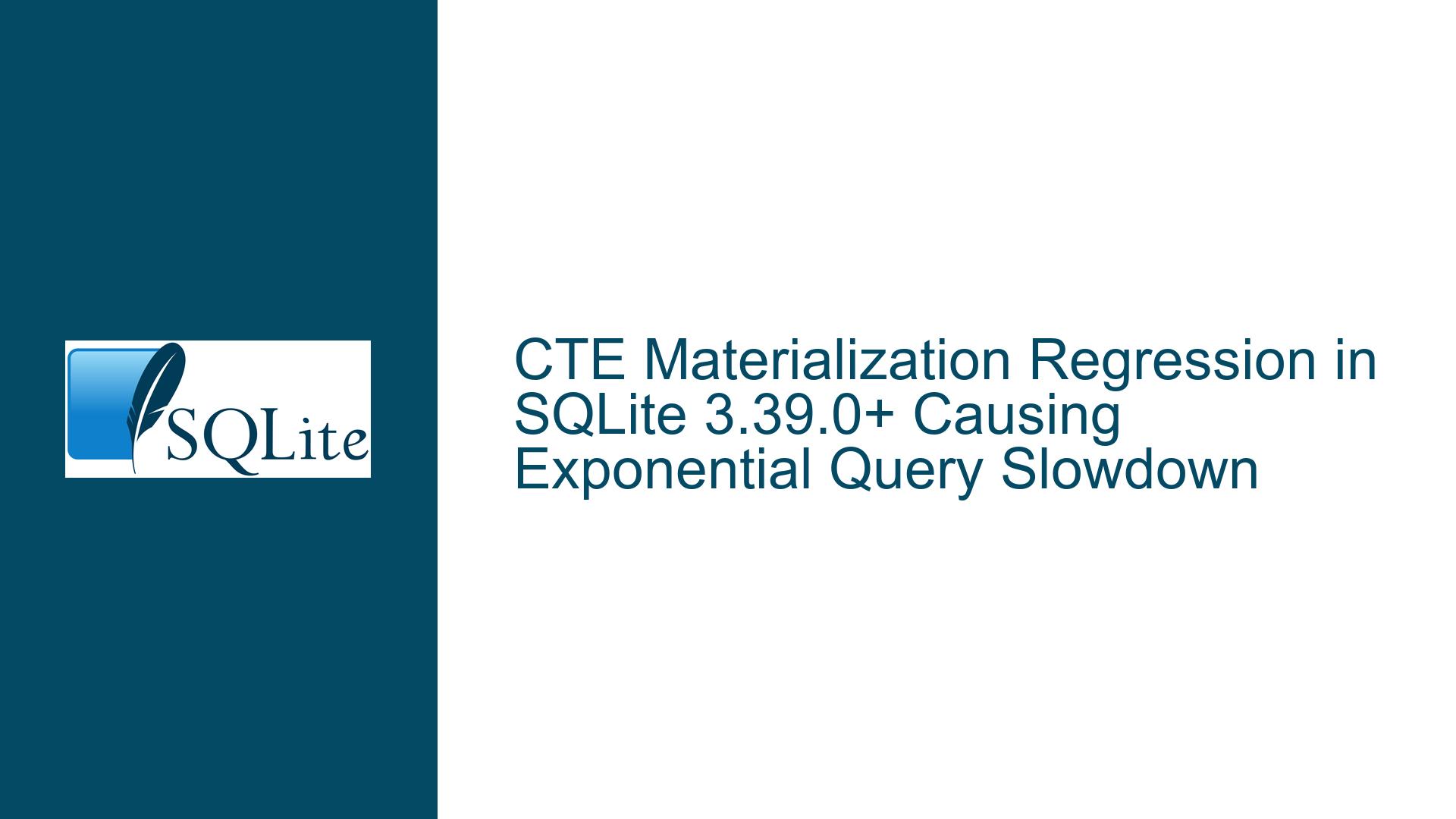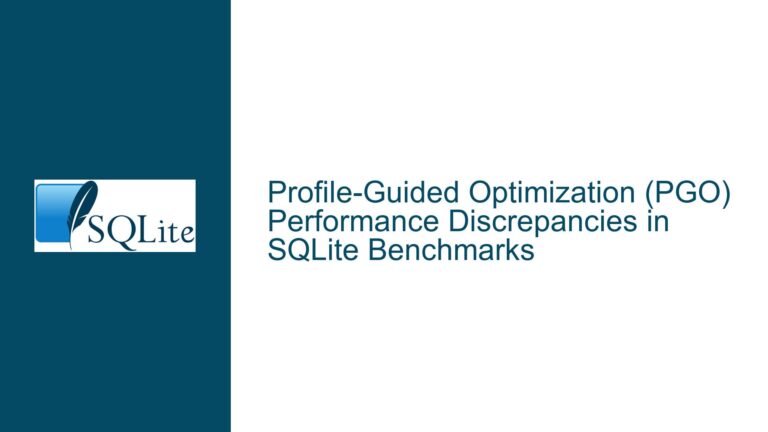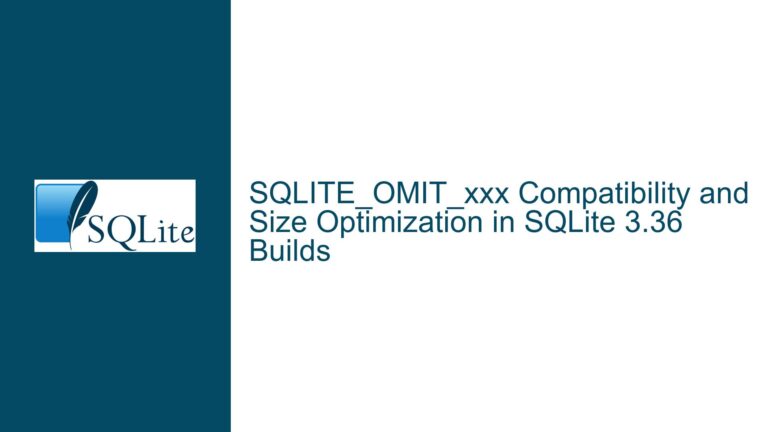CTE Materialization Regression in SQLite 3.39.0+ Causing Exponential Query Slowdown
Issue Overview: Degraded Query Performance Due to Suboptimal CTE Materialization
A significant performance degradation was observed in SQLite versions 3.39.0 through 3.40.1 for complex queries utilizing Common Table Expressions (CTEs). Queries that previously executed in seconds began requiring hours to complete. The root cause was traced to changes in how the SQLite query optimizer handles CTE materialization, specifically in scenarios where CTEs are referenced multiple times or involve UNION ALL operations across large datasets.
The problem manifests as excessive materialization of intermediate results into temporary B-trees, coupled with suboptimal automatic index selection. In the reported case, a query with nested CTEs (including UNION ALL operations across ACTIVITY_KIND_* tables) experienced a 10,000x performance penalty due to redundant materialization steps and inefficient row-scan patterns. The query plan revealed heavy use of MATERIALIZE directives for CTEs, while the fast version (using explicit temp tables) eliminated these steps and leveraged more efficient MERGE operations with automatic covering indexes.
Key technical markers include:
- Query Plan Differences: Slow plans show
MATERIALIZEsteps for all CTEs (e.g.,gpuops,range,overhead) withUSE TEMP B-TREE FOR ORDER BY/GROUP BY, while fast plans replace these withMERGE (UNION ALL)and streamlined index usage. - Automatic Index Mismanagement: The slow plan generated an automatic index on
starts(deviceId, pid, rowNum, start)that led to a catastrophicSEARCH startsoperation with 76.8 billion row iterations (loops=277,264 rows=76875325696). The fixed plan used a narrower index onends(rowNum, pid, deviceId, ...)with precise search constraints. - Version-Specific Regression: The issue was introduced in SQLite 3.39.0 with commit 8d631a6 (honoring MATERIALIZED keyword) and resolved in 3.41.1 via 66f29c4, which corrected overly aggressive CTE materialization heuristics.
Possible Causes: Query Optimizer Missteps in CTE Handling and Index Selection
1. Over-Materialization of CTEs
- Problem: The optimizer erroneously tagged CTEs with
M10d_Yes(materialize if used more than once) even when materialization provided no benefit. This forced repeated full scans of materialized CTEs instead of reusing precomputed results efficiently. - Impact: In the reported query, CTEs like
gpuops(a UNION ALL of three ACTIVITY_KIND_* tables) were materialized into temp B-trees, adding overhead for sorting and storage. Subsequent JOINs against these materialized CTEs failed to leverage optimal indexing strategies.
2. Automatic Index Selection Flaws
- Problem: The automatic index on
starts(deviceId, pid, rowNum, start)in the slow plan created a wide index that mismatched the search predicates (rowNum=? AND pid=? AND deviceId=?). This caused full index scans instead of direct lookups. - Impact: The
SEARCH startsoperation in the slow plan consumed 50% of total cycles (9.97 trillion cycles) due to mismatched index column order and unnecessary index width.
3. Union All Materialization Inefficiency
- Problem: UNION ALL operations across large tables (e.g., ACTIVITY_KIND_KERNEL, ACTIVITY_KIND_MEMCPY) were materialized into temp tables in the slow plan, while the fast plan used
MERGE (UNION ALL)to stream results without intermediate storage. - Impact: Materializing UNION ALL results forced unnecessary sorting (via
USE TEMP B-TREE FOR ORDER BY) and added I/O overhead for temporary storage.
4. Outdated Statistics or Missing ANALYZE Data
- Problem: Missing or stale SQLITE_STAT1 table entries could mislead the optimizer into preferring materialization over direct scans or MERGE operations.
- Impact: Without accurate row-count estimates, the optimizer might overvalue materialization for CTEs that would benefit from on-the-fly processing.
Troubleshooting Steps, Solutions & Fixes
Step 1: Confirm SQLite Version and Apply Patches
- Action: Verify SQLite version using
SELECT sqlite_version();. If the version is between 3.39.0 and 3.41.0, upgrade to 3.41.1 or later. - Rationale: The fix in 66f29c4 addresses the CTE materialization heuristic flaw. Post-upgrade testing showed a reduction from 19.9 trillion cycles to 2.48 billion cycles.
- Command:
# Download latest amalgamation wget https://sqlite.org/2023/sqlite-amalgamation-3410000.zip unzip sqlite-amalgamation-3410000.zip cd sqlite-amalgamation-3410000 gcc shell.c sqlite3.c -lpthread -ldl -o sqlite3
Step 2: Analyze Query Plans with EXPLAIN QUERY PLAN and .scanstats
- Action: Profile the query using
.scanstats onin the SQLite shell and compare pre/post-fix plans. - Rationale:
.scanstatsreveals per-operation cycle counts and row iterations, pinpointing bottlenecks like theSEARCH startsoperation. - Commands:
.eqp on .scanstats on EXPLAIN QUERY PLAN <your-query>; -- Execute query to see runtime stats
Step 3: Rewrite CTEs as Temporary Tables (Workaround for Pre-3.41.1 Versions)
- Action: Convert CTEs to explicit temp tables using
CREATE TEMP TABLE xyz AS SELECT .... - Rationale: Temp tables force materialization at controlled points and allow the optimizer to reuse results with efficient indexes.
- Example:
DROP TABLE IF EXISTS temp.gpuops; CREATE TEMP TABLE gpuops AS SELECT * FROM ACTIVITY_KIND_KERNEL UNION ALL SELECT * FROM ACTIVITY_KIND_MEMCPY UNION ALL SELECT * FROM ACTIVITY_KIND_MEMSET; -- Replace CTE references with temp.gpuops in main query
Step 4: Optimize Indexes and Statistics
- Action: Create covering indexes for JOIN predicates and run
ANALYZEto refresh statistics. - Rationale: Covering indexes eliminate redundant lookups, while updated statistics guide the optimizer away from materialization.
- Commands:
CREATE INDEX IF NOT EXISTS idx_activity_kernel ON ACTIVITY_KIND_KERNEL(pid, deviceId); ANALYZE;
Step 5: Use MATERIALIZED/NOT MATERIALIZED Hints (SQLite 3.35+)
- Action: Force or prevent CTE materialization using
MATERIALIZED/NOT MATERIALIZEDhints. - Rationale: Direct the optimizer to materialize only CTEs that benefit from it.
- Example:
WITH gpuops AS MATERIALIZED ( SELECT * FROM ACTIVITY_KIND_KERNEL UNION ALL SELECT * FROM ACTIVITY_KIND_MEMCPY ) SELECT ...;
Step 6: Bisect SQLite Versions to Identify Regression Scope
- Action: Use Fossil bisect to identify the exact commit causing regression.
- Rationale: Isolate the change responsible for performance shifts (e.g., 8d631a6).
- Commands:
fossil clone https://www.sqlite.org/src sqlite.fossil cd sqlite fossil bisect start fossil bisect bad trunk # Mark current trunk as bad fossil bisect good version-3.38.0 # Last known good version # Test each bisect step with query timing
Step 7: Review Automatic Indexing Decisions
- Action: Disable automatic indexing temporarily (
PRAGMA automatic_index=OFF;) to test if manual indexes perform better. - Rationale: Automatic indexes may not always match query predicates optimally.
- Commands:
PRAGMA automatic_index=OFF; -- Re-run query with manual indexes PRAGMA automatic_index=ON;
Step 8: Simplify Query Structure
- Action: Flatten nested CTEs, eliminate redundant sorts, and replace non-deterministic GROUP BY clauses with explicit window functions.
- Rationale: Complex CTE nesting confuses the optimizer; simpler queries are more likely to receive optimal plans.
- Example:
-- Before: Nested CTEs WITH gpuops AS (SELECT ...), range AS (SELECT ... FROM gpuops ...) SELECT ...; -- After: Flattened subqueries SELECT ... FROM ( SELECT ... FROM ( SELECT * FROM ACTIVITY_KIND_KERNEL UNION ALL SELECT * FROM ACTIVITY_KIND_MEMCPY ) AS gpuops ... ) AS range;
Step 9: Monitor Temp Store Usage
- Action: Check temp store configuration (
PRAGMA temp_store;) and ensure sufficient memory allocation. - Rationale: Excessive B-tree materialization may overflow to disk if
temp_store=0(default), causing I/O bottlenecks. - Commands:
PRAGMA temp_store=MEMORY; -- Keep temp tables in RAM -- Or allocate more space PRAGMA cache_size=-200000; -- 200MB cache
Step 10: Engage SQLite Community for Custom Builds
- Action: Provide a reproducible test case to the SQLite team via forum or private email.
- Rationale: Edge cases in optimizer behavior require expert analysis. The SQLite team rapidly addresses verified regressions.
By systematically applying these steps—particularly upgrading to SQLite ≥3.41.1 and restructuring CTEs—the exponential slowdown caused by CTE materialization regressions can be resolved. Future-proof queries by favoring explicit temp tables for heavy intermediate results and leveraging the latest optimizer improvements in SQLite.






